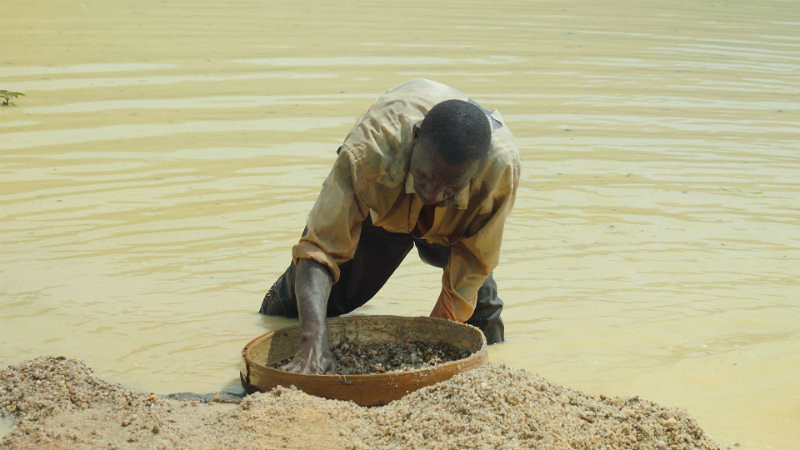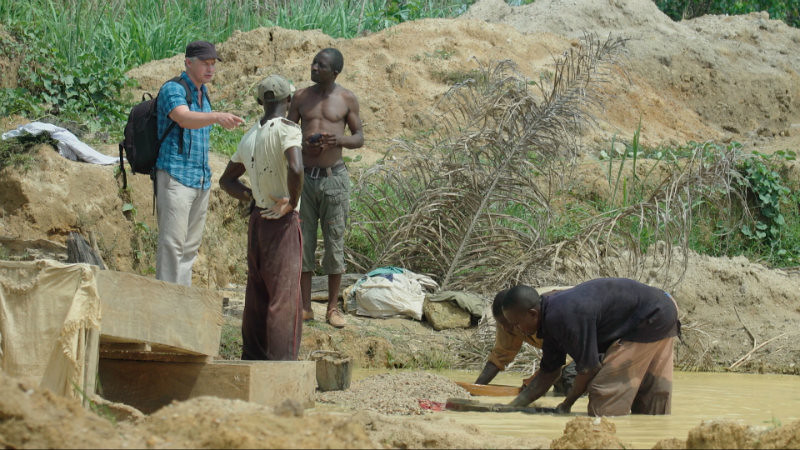Resource information
Our new feature film from Roy Maconachie and Simon Wharf explores the pathway of a diamond from mine to market, and asks the question, who really benefits?
Diamonds are big business in Sierra Leone. Dispersed over terrain spanning some 8,000 square miles (almost a quarter of the entire country), an abundance of the precious – and extremely valuable – stones have made the diamond sector one of the country’s most lucrative foreign currency generators. In the past, annual production has netted up to US$250 million, making the small West African country diamond rich bar none.
Yet, the country’s wealth in natural resources – gold, iron ore, bauxite and rutile are also found extensively within its borders – has not correlated into better living conditions for its people. In fact, the opposite has been true. By UNDP standards, 60% of the country live under the poverty line, making it one of the world’s poorest nations. Ravaged for years by a brutal civil war – fuelled by an illicit trade in diamonds - and battered more recently by Ebola, economic development has flatlined through a combination of mismanagement and misfortune.
Part of that story, Sierra Leone’s troubled relationship with diamonds, was told to a global audience 12 years ago in the Hollywood blockbuster, ‘Blood Diamond’, starring Leonardo DiCaprio. The film focused global attention on the human cost of conflict diamonds and shone a spotlight on the Kimberley Process – the international certification scheme designed to eradicate them from the international market. Mention a new film about diamonds in Sierra Leone, and it’s hard to get away from immediate comparisons.
“When I talk to my students about my work on diamonds in Sierra Leone that’s always their first reaction – Blood Diamond”, says Dr Roy Maconachie, Reader in International Development in our Centre for Development Studies, and co-producer of a brand new University feature film focusing on the locally-grounded stories of people involved in the diamond mining industry in Sierra Leone. “But where Blood Diamond successfully drew attention to conflict diamonds and really moved the agenda forward, it also overshadowed a whole set of other important issues that are impacting miners, the conditions they work in and the real benefits they accrue.”
Roy’s interests lie in value chains within the artisanal diamond sector, specifically the economic disparities that exist between those selling diamonds in jewellery shops right at the top of the chain, and those digging diamonds out of the ground at the very bottom. “Diamonds are a classic ‘lootable’ resource; small, transportable and extremely valuable, and the way in which the sector operates informally means that there are clear reasons why the potential benefits that the industry could bring often do not correlate locally."
A photographer by background, Roy is all too aware of the power of images to tell a compelling story. It’s these human stories depicted in the value chain – told by those individuals involved at all stages of the diamond’s journey from mine to market – that form the backbone of his latest film ‘Voices from the Mine’.
“Film is something I’ve always been interested in, and it’s a great medium for translating messages from research, and sharing them with a much wider audience” he says. “This latest project builds on some of my earlier work in Sierra Leone, but looks at these issues in greater detail. The challenges explored in the film go far beyond academic enquiry: they are significant livelihood issues, the day-to-day pressures faced by many poor people in Kono District in Sierra Leone.”
His previous projects have included an award-winning documentary about female cocoa farmers involved in Fairtrade in Ghana and a pre-cursor to this latest film, albeit on a much smaller scale, about alluvial mining in Sierra Leone. Both times he worked with in-house University filmmaker Simon Wharf from our Audio Visual Unit, with whom he again collaborates this time.
Shot mainly on location in Kono District in Sierra Leone, the 30-minute film also includes sequences and interviews in Antwerp – one of the world’s main diamond centres.
The film has been produced on a scale not previously attempted, thanks in large part to funding from Bath alumnus and founder and CEO of the US-based philanthropic organisation Humanity United, Randy Newcomb. That support has also extended to fund Felix Conteh, a Sierra Leonean post-doc researcher who, whilst conducting fieldwork on the ground with Roy, was instrumental as a fixer in setting up interviews for the film with key players.
“The central story that emerges from the film, and the key issue that really needs to be addressed in policy, is that this industry operates in a very unregulated and unequal sphere. The artisanal diamond sector is informal, with low barriers to entry, meaning that it is possible for anyone to come and work in the mine” explains Roy. “That’s a particular challenge for those wishing to bring about change, formalising the sector in some way. But it’s not an intractable one given there’s an appetite to address this both from international donor organisations and, in part, from the Sierra Leonean government.”
Roy hopes that the film will play a role in giving a voice to those individuals involved in this industry – particularly those at the bottom of the chain – so that their stories are reflected in evolving policy agendas. Following a première at The Edge, follow-on screenings will take place around the world, including in Sierra Leone, for the UK Department for International Development, and in the US. In addition to the film, Roy and Felix will work on academic papers and policy briefs to support their findings.
He also hopes that the film will give consumers at the top of the chain food for thought. “It is clear that many people just aren’t aware of the realities of life for those involved in this industry. After all the attention that the Kimberley Process has received, if a diamond has a certificate, many people nowadays might understandably assume that everything is ok. But this is not always the case.”
“Film can be such a powerful way of exposing problems that remain invisible, and showing people visually that things are not always ok. It’s important to question and think in greater detail about what we are buying. And if we’re reaching out and getting people to reflect on where these diamonds are coming from, that’s a good outcome for the film.”
A troubled history with diamonds

The power of film to tell a story

Supported by Humanity United

‘Capturing the colours, textures and sounds of what I discovered to be a vibrant and welcoming country was an experience I will never forget, but of course it is the stories of the people we met that will remain with me the longest.’

